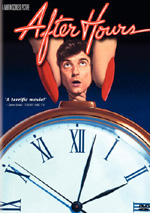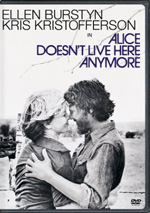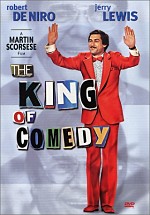|
WARNER
|

| |
|
MOVIE INFO
|
|
Director:
Martin Scorsese
Cast:
Griffin Dunne, Rosanna Arquette, Verna Bloom, Tommy Chong, Linda Fiorentino, Teri Garr, John Heard, Cheech Marin, Catherine O'Hara
Writing Credits:
Joseph Minion
Tagline:
When it's after midnight in New York City, you don't have to look for love, laughter and trouble. They'll all find you!
Synopsis:
Take an eventful one-night trip through the bizarre underworld of New York City as a regular guy (Griffin Dunne) is unwittingly thrust into a series of comic misadventures when he loses his cab fare late at night in Manhattans Soho district. Joseph Minion's tightly constructed script, combined with Martin Scorsese's stylish direction, makes After Hours a highly entertaining ride that takes the "this night couldn't get any worse" concept to an entirely new level.
Box Office:
Budget
$4.500 million.
Domestic Gross
$10.600 million.
MPAA:
Rated R
| |
|
DVD DETAILS
|
Presentation:
Widescreen 1.85:1/16x9
Audio:
English Monaural
French Monaural
Subtitles:
English
French
Spanish
Closed-captioned
Runtime: 112 min.
Price: $19.97
Release Date: 8/17/2004
Bonus:
• Audio Commentary with Director Martin Scorsese, Actor Griffin Dunne, Producer Amy Robinson, Editor Thelma Schoonmaker, and Cinematographer Michael Ballhaus
• ďFilming For Your LifeĒ Documentary
• Deleted Scenes
• Trailer
| |
|
PURCHASE @ AMAZON.COM
|

| |
|
EQUIPMENT
|
Sony 36" WEGA KV-36FS12 Monitor; Sony DA333ES Processor/Receiver; Panasonic CV-50 DVD Player using component outputs; Michael Green Revolution Cinema 6i Speakers (all five); Sony SA-WM40 Subwoofer.
| |
|
RELATED REVIEWS
|


| |
|
After Hours (1985)
|
|
Reviewed by Colin Jacobson (October 7, 2004)
After making a name for himself as one of the great directors with his works through 1980ís Raging Bull - often cited as that eraís best film - Martin Scorsese seemed somewhat lost for the rest of the decade. He produced a few good but flawed flicks like King of Comedy and Last Temptation of Christ, but he also put out mediocre affairs such as The Color of Money. Heíd rebound solidly with 1990ís GoodFellas, though that flick may stand as his last true hurrah, since heís not approached its level of quality since then.
Scorseseís least interesting effort from the Eighties comes with 1985ís After Hours. In it, we meet office worker Paul Hackett (Griffin Dunne), who leads a dull, solitary life. He sits alone in a diner when he meets Marcy (Rosanna Arquette) and the pair connect on Tropic of Cancer. They chat briefly and he gets the number for a sculptor friend of hers named Kiki Bridges (Linda Fiorentino) who makes bagel paperweights.
Paul calls and inadvertently gets Marcy, who invites him over at 11:32 PM. Paul takes a wild cab ride there and loses his money out the window. Marcyís at the drugstore when Paul arrives, so he talks to Kiki and helps with her art. Marcy returns and they hang out, which starts a series of complications. She eventually reveals some personal information about a rape that occurred in the same room and also notes that her husband Franklin owns the loft.
Things get weirder from there. Paul senses emotional issues in Marcy, and he eventually freaks out after he smokes some pot. Paul leaves the loft in a huff and goes to a bar.
From thereÖ lots of things happen, too much for me to continue to detail in a plot synopsis. Suffice it to say that Paul meets lots of characters, all of whom complicate his life. All he wants to do is get home, but a variety of problems prevent this from occurring, all in comedic ways.
Or allegedly, purportedly comedic ways, for I didnít find a lot of laughs in After Hours. Actually, much of the flick is plain old dull. It does improve as it progresses, and the third act fares better than the prior two. However, by that point, it seems too little, too late, for the first two-thirds of the movie are fairly tedious.
A lot of the problem stems from its transparent attempts at cleverness. Thereís nothing worse than forced quirkiness, and Hours has that in spades. It wants to be a wacky farce as it places all sorts of obstacles in Paulís way, but much of the time, it lacks the appropriate energy and life. Itís tough to pull off this sort of flick, and Scorsese isnít the right director for it. Heís good with gritty and dark, and those elements come out neatly here, but the comedic parts turn into more of a struggle.
Ultimately, the biggest problem with After Hours simply comes from its plodding pace. It evolves slowly and fails to engage until late in the game. Even then, it only seems sporadically entertaining, but at least it ends on a moderately high note. Otherwise, itís a self-consciously cutesy and quirky effort that doesnít really go anywhere.
|
The DVD Grades: Picture B-/ Audio C/ Bonus B
|
|
After Hours appears in an aspect ratio of approximately 1.85:1 on this single-sided, double-layered DVD; the image has been enhanced for 16X9 televisions. The transfer seemed generally satisfying but not anything exceptional.
Sharpness was mostly good. At times the image looked a bit soft and ill-defined, but not with much frequency. Instead, the flick usually came across as reasonably detailed and distinctive. No issues with jagged edges or shimmering occurred, but I noticed a little light edge enhancement. While the prior three Scorsese Collection DVDs I watched came with almost no defects, Hours was noticeably dirtier. It didnít seem terribly problematic, but it displayed a moderate number of specks throughout its running time.
Given its urban, nighttime setting, it came as little surprise that Hours presented a fairly drab palette. Occasional examples of brighter hues occurred, but mostly the colors were generally without much vivacity. Some of that came from the movieís visual scheme, but parts of it resulted from the usual flatness found in many Eighties flicks. This meant the tones were acceptable for the most part but failed to deliver liveliness. Blacks followed suit, as they were moderately deep but not too strong, and shadows came across as passably visible but somewhat opaque and flat. Itís a decent transfer but not one that stood out as substantially above average.
In addition, the monaural soundtrack of After Hours seemed mediocre at best. Speech was intelligible but somewhat bland, and I noticed occasional examples of edginess and scratchiness. Effects appeared lackluster, though they remained acceptably defined and clear and didnít suffer from any distortion. Music varied dependent on the source. Since the music mostly came from older songs, their quality was erratic. The tunes generally seemed passable, but they didnít present much depth or range most of the time. The music at the punk club was definitely the strongest presentation, as those elements presented surprisingly positive bass after the blandness of the prior bits. The occasional examples of score fell somewhere in between the thinness of the source songs and the life of the club shots. Some hiss appeared at times. Overall, the track didnít come across as bad, but it was average for a movie from 1985.
When we head to the extras, we start with an audio commentary with director Martin Scorsese, actor Griffin Dunne, producer Amy Robinson, editor Thelma Schoonmaker, and cinematographer Michael Ballhaus. All five were recorded separately for this edited, occasionally-screen-specific piece. The commentary doesnít fill the movieís entire running time, as it skips some parts and lasts a total of 78 minutes and eight seconds.
Scorsese starts the track on a strong note as he provides an extended monologue about what attracted him to the project and the problems related to Last Temptation of Christ that ultimately took him to Hours. However, Ballhaus emerges as the real dominant presence of the commentary. A more technical piece than the other Scorsese Collection tracks, he discusses various photographic techniques and styles in the film along with other production notes as well as information about his career. The others fill in remarks about how they got onto the project plus a mix of additional facts about the shoot and elements like deleted scenes. Overall, this is a brisk and informative commentary.
Up next we get Filming for Your Life, a new 18-minute and 40-second featurette about Hours. We get notes from Scorsese, Dunne, Robinson, Schoonmaker, We hear the basics of how the project came to fruition, the filmís rapid schedule, shooting at night, Scorseseís shotlist, the movieís tone, some of the directorís techniques, Dunneís acting choices, and finding an ending. Some of the information repeats from the commentary, but plenty of new details emerge such as the fact that the producers almost hired Tim Burton to direct. Itís a tight and engaging look at the flick.
In addition to the filmís theatrical trailer, we locate a collection of seven deleted scenes. All together, these last eight minutes and five seconds. These offer a mix of expository scenes plus additional comedic bits like Paulís rough night staying at Tomís apartment. Thereís nothing exceptional, but fans will enjoy these clips.
A stylistic stretch for Martin Scorsese, After Hours doesnít succeed. It presents occasional moments of dark mirth, but it plods too much and seems generally dull and pointless. The DVD offers decent but unexceptional picture with mediocre audio and some interesting extras. One of Scorseseís less compelling efforts, leave this one for the completists.
Note: After Hours can be purchased on its own or as part of the Martin Scorsese Collection. The latter includes Hours along with the new special editions of Mean Streets, GoodFellas, Whoís That Knocking On My Door?, and Alice Doesnít Live Here Anymore. Separately, those five retail for $106.87, but the Collection goes for a mere $59.92. That makes it a real steal for Scorsese fans.
|
|
Viewer Film Ratings: 4.5882 Stars | Number of Votes: 17 |
|
|

